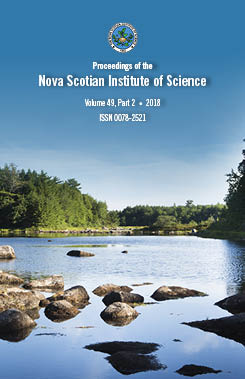The trout fishery of the upper Medway watershed, Nova Scotia, 2016-17
DOI:
https://doi.org/10.15273/pnsis.v49i2.8163Abstract
During the spring of 2016 and 2017, the Mersey Tobeatic Research
Institute (MTRI), in collaboration with the Nova Scotia Department of Fisheries and Aquaculture, conducted an angler creel survey in the Medway Lakes Wilderness Area that is located within the upper Medway watershed. Since 2012, public access to this region was improved to numerous lakes and streams, increasing the risk of overexploitation and the illegal introduction of invasive fish species. The purpose of this study was to assess the current status of the fishery for Brook trout, Salvelinus fontinalis, investigate the possible presence of invasive Smallmouth bass, Micropterus dolomieu, and Chain pickerel, Esox niger, and inform anglers of the effects of invasive species on local biodiversity. Over the course of this two-year study, a total of 264 anglers spent 1017 hours to catch 1279 trout, of which 74% were released. Median length of retained Brook trout was of 25 cm and the maximum length was 43 cm. The majority of the catch was 2+ and 3+ years old. Angler catch rates were similar to nearby Kejimkujik National Park and greater than in the Tangier Grand Lakes Wilderness Area. The study area does not currently appear to be inhabited by invasive fish species. Most of the anglers interviewed lived nearby and had a long history of fishing in the upper Medway watershed. The study provides baseline data from the trout fishery which could be used to evaluate management strategies and future impacts of invasive fish species.


